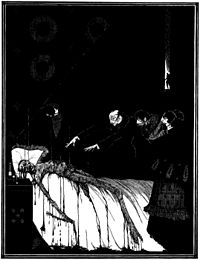The Facts in the Case of M. Valdemar
| "The Facts in the Case of M. Valdemar" | |
|---|---|

Illustration for "The Facts in the Case of M. Valdemar" by Harry Clarke, 1919.
|
|
| Author | Edgar Allan Poe |
| Country | United States |
| Language | English |
| Genre(s) | Suspense, hoax |
| Published in | The American Review and Broadway Journal (simultaneously) |
| Publication type | Periodical |
| Media type | Print (Magazine) |
| Publication date | December 1845 |
"The Facts in the Case of M. Valdemar" is a short story by American author Edgar Allan Poe about a mesmerist who puts a man in a suspended hypnotic state at the moment of death. An example of a tale of suspense and horror, it is also, to a certain degree, a hoax, as it was published without claiming to be fictional, and many at the time of publication (1845) took it to be a factual account. Poe toyed with this for a while before admitting it was a work of pure fiction in his marginalia.
The narrator presents the facts of the extraordinary case of his friend Ernest Valdemar, which have incited public discussion. He is interested in mesmerism, a pseudoscience involving bringing a patient into a hypnagogic state by the influence of magnetism, a process that later developed into hypnotism. He points out that, as far as he knows, no one has ever been mesmerized at the point of death, and he is curious to see what effects mesmerism would have on a dying person. He considers experimenting on Valdemar, an author whom he had previously mesmerized, and who has recently been diagnosed with phthisis (tuberculosis).
Valdemar consents to the experiment and informs the narrator by letter that his doctors expect him to die by midnight of the following evening. Valdemar's two physicians inform the narrator of their patient's poor condition. After confirming again that Valdemar is willing to be part of the experiment, the narrator comes back the next night with two nurses and a medical student as witnesses. Again, Valdemar insists he is willing to take part and asks the narrator to hurry, for fear he has "deferred it for too long". Valdemar is quickly mesmerized, just as the two physicians return and serve as additional witnesses. In a trance, he reports first that he is dying — then that he is dead. The narrator leaves him in a mesmeric state for seven months, checking on him daily with the help of physicians and friends. During this time Valdemar is without pulse, heartbeat or perceptible breathing, his skin cold and pale.
...
Wikipedia
